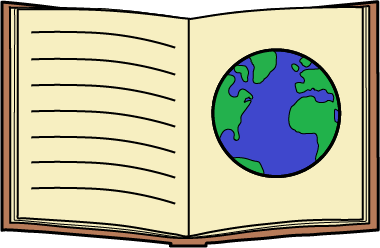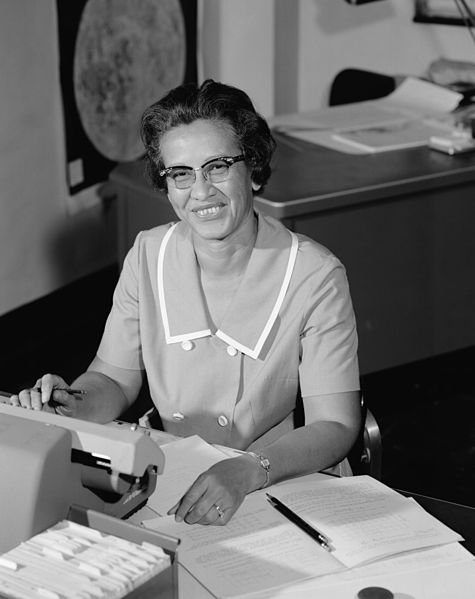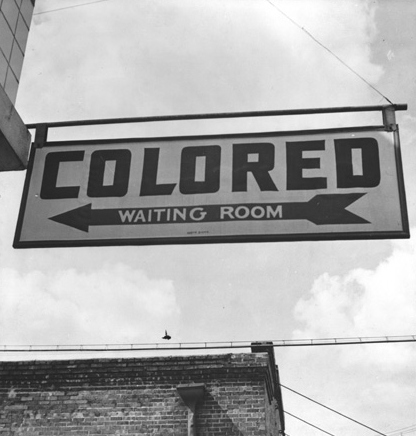
Katherine Johnson was a woman that loved math. She was also a black American. She faced and overcame many things in her life. There were many laws and rules against her race. Despite her struggles, she made good things count for her through hard work.

As a young girl Katherine skipped several grades in school because she was curious and smart. By the age of 13 she attended high school. At 18 she went to college at West Virginia State and graduated with honors in 1937. After she got her degree she taught school at a black public school in Virginia.
Then, Katherine left teaching to enroll in more college. She started a program for a higher degree at West Virginia University. It had decided to integrate some programs. She and two black males were invited. But, at the end of the first session, things changed. Ms. Johnson left school. She had decided to start a family with her husband James Goble.
Katherine and her husband had three daughters. Then she got back into the workforce. She returned to teaching for a while. A little later she heard about work somewhere else. It was at the National Advisory Committee for Aeronautics (NACA). The new job was in Langley, Virginia. Later NACA became NASA. NASA stands for The National Aeronautics and Space Administration. The jobs were at the all-black West Area Computing section, a segregated work group. She took a job there working for Dorothy Vaughan. Two weeks later she was assigned to work for the Flight Research Group. While working in flight research her husband, James, died of cancer in December 1956.

In 1957 the Soviets launched a satellite called Sputnik. That event had a big effect on Katherine's life. Our country did not want to get behind in our work in space. Russia was ahead of us. Our country decided to get to work on it. Katherine did math work for us. She worked on the flight path of one of America’s spaceflights. It was called the Friendship 7 flight. John Glen was the one who flew the spaceship. It made orbits of the earth. Katherine used her math skills to check things out for that flight. When they ran into some questions about whether everything was ready, John Glen asked the engineers to "get the girl" to check the calculations.
Later, Katherine worked on other flights. She worked on the Apollo landing on the moon and the Space Shuttle.
Katherine Johnson led a remarkable life. She accomplished some noteworthy things. In addition to her important work in the space program of our country she authored or coauthored 26 research reports. She worked at Langley for 33 years. Of her work there she said, "I loved going to work every single day."

In 1949 Dorothy Vaughan was the boss of a group of women. It was a group she had hired. She was in charge of them. Dorothy had been promoted as their supervisor. They were called 'human computers.' They were called this because they computed numbers. This means that they figured out number problems. There was something else about her workers. They were all 'colored' or black. She hired African American women. They were called 'colored' by many at that time. Her workers were part of a segregated group that was building our nation's space program. The name of the program was the National Advisory Committee for Aeronautics' (NACA's) West Area Computing Unit. Ms. Vaughan worked as the head of this group from 1949 until 1958. She had become the first African-American manager in NACA. She was also a respected mathematician.

Women were being hired to figure out the numbers for the space program, but whites and blacks worked in separate, segregated groups. The all-black group had to eat in a separate dining room and use separate bathrooms. The group of 'West Computers' was a group that really stood out. They did a good job at their work. They also put up with the segregation laws and rules.
One of the things that Dorothy helped do was to put together a handbook of algebra methods. Workers had to know their math skills, but the handbook helped them out. It helped them figure out problems they worked on with their calculating machines.
When NACA became NASA the West Computing office was closed. Dorothy and many of her workers joined a new division. It was an integrated place to work. Whites and blacks worked together. Ms. Vaughan learned a new programing language. It was called FORTRAN. This was the program to run the new computers they had started to use. She became an expert at it.

Vaughan was a respected leader. Other people Dorothy worked with trusted her. When they needed advice they would ask her. They knew they could turn to her for help and answers. Ms. Vaughan also looked out for and assisted other women. She tried to give them work opportunities.
Mary Jackson was a woman that loved learning. She got college degrees in math and science. Then she taught school for a year. The school was at a black school in Maryland. In 1951 she got a job at the West Area Computing offices. This was a group that was part of the Langley Memorial Aeronautical Laboratory. Her boss was Dorothy Vaughan, another black mathematician. She worked here two years. This began a new course for more learning for her.

Then Mary was offered a spot to work as an engineer. She worked in a wind tunnel were they would do testing work. Before long she was offered an opportunity to become an engineer. In order to do it she would have to take night classes. The problem was that the classes were held at a segregated school, Hampton High. She had to get special permission to go. She did not change her mind. Even when she was faced with many Jim Crow Laws and challenges she kept moving forward. She got the permission she needed. She then completed the courses and got the promotion. She became the first, black, female engineer for NASA.

Mary went on to have a successful career. She worked for almost 20 years as an engineer. Jackson helped other women find jobs. She also volunteered and served in many ways to help other people be successful.

Katherine Johnson
https://www.nasa.gov/content/katherine-johnson-biography
Dorothy Vaughan
https://www.nasa.gov/content/dorothy-vaughan-biography
Mary Jackson
https://www.nasa.gov/content/mary-jackson-biography
Image Credits:
Katherine Johnson at NASA in 1966 - a mathematician and Physicist who helped in calculating the flight path of John Glen in 1962 by NASA- Wikimedia Commons;
NASA logo.svg by NASA- Wikimedia Commons;
Dorothy Vaughan an African American human computer for NASA by Beverly Golemba and NASA- Wikimedia Commons;
Segregated 1943 Colored Waiting Room Sign by Esther Bubley Library of Congress;
NACA logo by NACA and NASA 799px- Wikimedia Common;
Mary Jackson working at NASA by NASA- Wikimedia Commons;
Apollo program insignia 599px from NASA- Wikimedia Commons